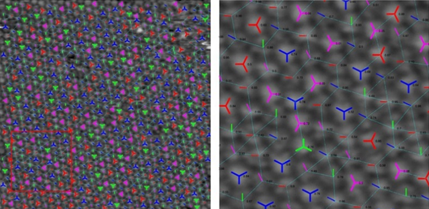 Learning surface molecular structures via machine vision(由机器视觉学习表面分子结构)
Learning surface molecular structures via machine vision(由机器视觉学习表面分子结构)
Maxim Ziatdinov,Artem Maksov&Sergei V. Kalinin
npj Computational Materials 3:31 (2017)
doi:10.1038/s41524-017-0038-7
Published online:10 August 2017
Abstract| Full Text | PDF OPEN
摘要:高分辨率扫描透射电子显微镜和扫描探针显微镜的最新技术能使研究人员对材料结构参数和功能特性进行测量,测量精度可达皮米(10-12m)级,测量环境如同日常空间。然而,在许多技术上相关的原子和/或分子系统中,人们想要的信息却以非均匀的方式在空间分布,还可能出现复杂的多维性。因此,一个关键的问题在于,能否准确地识别(“读出”)不同原子/分子建构(atomic / molecular architectures)中的所有单个构件(building blocks),以及这些构件可能形成的更为复杂的图案(规模在数百到数千个单独的原子/分子单位)。本研究采用机器视觉来读取和识别材料表面的复杂构件。具体来说,结合马尔科夫随机场模型和卷积神经网络模型,应用高分辨率扫描隧道显微镜作可视化测量,对金属表面分子组装中的所有单个构件的结构和旋转状态进行分类。研究发现,系统获得的完整解码可使我们能够直接构建一对密度函数,该密度函数既是分析无序-属性关系范式的核心,又是分析纳米级多阶参数之间的空间关系,并可阐明涉及分子构象变化的反应途径。本方法的建立,标志着我们对原子和/或分子分辨显微镜图像的分析方式有了显著变化,本方法还可应用于显微测量各种不同浓缩物体系的结构、电子和磁顺序。
Abstract:Recent advances in high resolution scanning transmission electron and scanning probe microscopies have allowed researchers to perform measurements of materials structural parameters and functional properties in real space with a picometre precision. In many technologically relevant atomic and/or molecular systems, however, the information of interest is distributed spatially in a non-uniform manner and may have a complex multi-dimensional nature. One of the critical issues, therefore, lies in being able to accurately identify (‘read out’) all the individual building blocks in different atomic/molecular architectures, as well as more complex patterns that these blocks may form, on a scale of hundreds and thousands of individual atomic/molecular units. Here we employ machine vision to read and recognize complex molecular assemblies on surfaces. We show how the obtained full decoding of the system allows us to directly construct a pair density function—a centerpiece in analysis of disorder-property relationship paradigm—as well as to analyze spatial correlations between multiple order parameters at the nanoscale, and elucidate reaction pathway involving molecular conformation changes. The method represents a significant shift in our way of analyzing atomic and/or molecular resolved microscopic images and can be applied to variety of other microscopic measurements of structural, electronic, and magnetic orders in different condensed matter systems.
Editorial Summary
Machine learning: Computers automatically decode complex molecular patterns (机器学习:计算机自动解码复杂的分子图案)
基于该研究结果,现在可通过计算机对材料表面的数千个分子形成的复杂图案进行自动识别和分类。美国橡树岭国家实验室的Sergei Kalinin(本刊学术编辑)、Maxim Ziatdinov和ArtemMaksov开发了一种“机器视觉”方法,对已在癌症检测和卫星成像中使用的技术进行改进,以使其能够对金表面所谓“buckybowl”分子(一种心环烯)的微观图像,作高达1000s的单个分子构象分析。这类碗形分子可以面朝上或朝下放置,有不同的旋转取向,分子排列起来犹如图案丰富的挂毯,分子图案纷繁复杂,以致于无法用手工或现有计算方法进行分类。然而,他们所开发的机器视觉方法却能揭示buckybowls如何与邻居相互作用、构建出复杂阵列的细节,并有望用于分子存储器件的设计。
Complex patterns formed by thousands of molecules on a surface can now be automatically recognized and classified by a computer. Sergei Kalinin, Maxim Ziatdinov and ArtemMaksov at Oak Ridge National Lab have developed a ‘machine vision’ approach, adapting techniques already used in cancer detection and satellite imaging, to analyze up to 1000 s of individual molecular configurations from microscopic images of so-called ‘buckybowl’ molecules on gold surfaces. These bowl-shaped molecules may rest face up or down, and can adopt different rotational orientations, resulting in a rich tapestry of molecular patterns which are too complicated to sort manually or with existing computational methods. However, this machine vision approach revealed details of how buckybowls interact with their neighbors to build complex arrays, which could help in the design of molecular memory devices.


 沪公网安备 31010502006565号
沪公网安备 31010502006565号